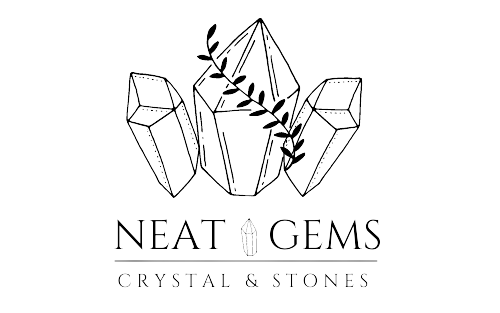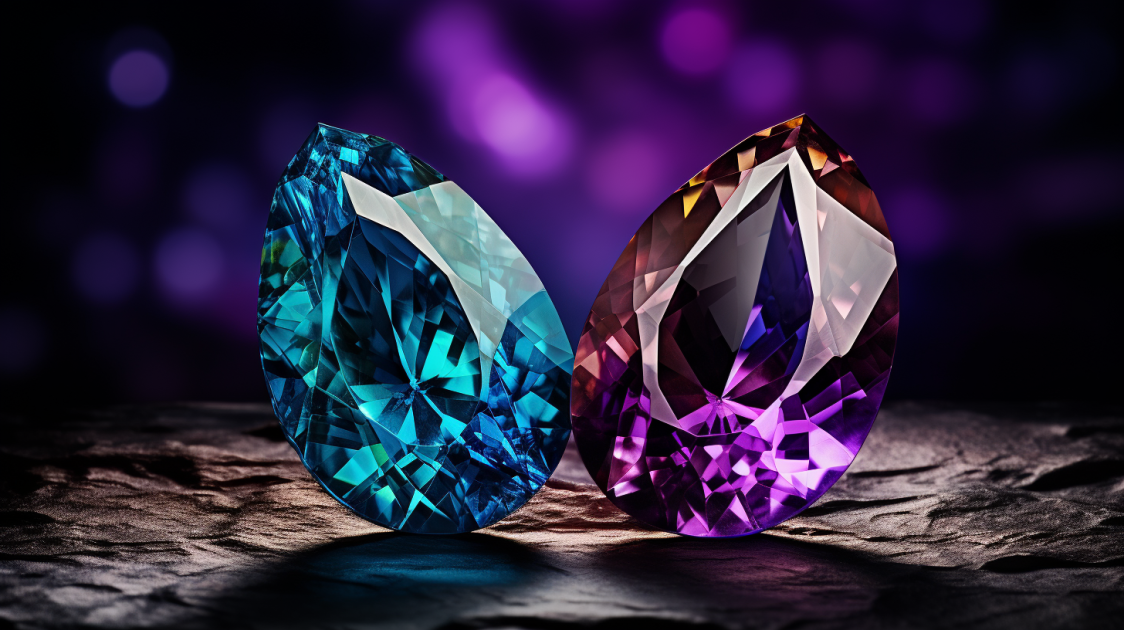Are you ready to unlock the power of gemstones and embrace your inner strength? Imagine this: you’re at a glamorous soirée, dressed in your finest attire, when a shimmering jewel catches your eye. It’s as if time stands still, and all eyes are on you. You reach out to touch it, feeling its energy pulsating through your fingertips. This captivating gemstone is none other than alexandrite.
But wait! Before you dive headfirst into the world of alexandrite, there’s another gemstone that demands your attention – amethyst. Both these gems possess unique qualities that set them apart from the rest. And understanding their differences will not only enhance your jewelry collection but also empower you to make bold choices.
From color comparison to rarity and value, this article will delve deep into the nuances that differentiate alexandrite from amethyst. We’ll explore their metaphysical properties, durability, and even discuss jewelry applications. So get ready to uncover the secrets behind these magnificent gemstones and embark on a journey towards self-discovery and empowerment like never before!
Key Takeaways
- Alexandrite is a scarce gemstone sourced from Brazil, Sri Lanka, and Russia, while amethyst is readily available and sourced from Brazil, Uruguay, and Zambia.
- Alexandrite has a color change effect, while amethyst is known for its rich purple hue.
- Alexandrite has a higher market value due to its rarity, while amethyst has a lower market value.
- Both gemstones have healing properties and spiritual significance, with amethyst promoting relaxation and stress relief, and alexandrite bringing balance and harmony.
Color Comparison
When it comes to color, alexandrite and amethyst each have their own unique and captivating hues that can truly enchant anyone who lays their eyes on them. The color intensity of alexandrite is what sets it apart from other gemstones. It displays a mesmerizing color change effect, ranging from green in daylight to red under incandescent light. On the other hand, amethyst exhibits a rich purple hue that is both regal and commanding. While both gemstones are found in various parts of the world, alexandrite is known for its scarcity and can be sourced from Brazil, Sri Lanka, and Russia. Amethyst, on the other hand, is more readily available and can be found in Brazil, Uruguay, and Zambia. Moving on to rarity and value…
Rarity and Value
Despite their differences in rarity and value, these gemstones offer distinct beauty and allure. When it comes to market demand, alexandrite is highly sought after due to its scarcity. This remarkable gemstone is extremely rare, making it a true treasure for collectors and enthusiasts. On the other hand, amethyst is more commonly found and therefore has a lower market value. Gemstone grading also plays a significant role in determining their worth. Alexandrite’s exceptional color-changing properties and overall quality contribute to its higher value in the market. Amethyst, although less valuable, still possesses its own unique charm with its captivating purple hues. Transitioning into the next section about ‘metaphysical properties’, it’s important to note that both alexandrite and amethyst are believed to possess powerful metaphysical properties that make them even more intriguing as gemstones of choice.
Metaphysical Properties
With their distinct beauty and allure, do these gemstones possess powerful metaphysical properties that add to their overall charm? Both alexandrite and amethyst are believed to possess healing properties and spiritual significance. Amethyst is known for its calming energy, promoting relaxation and stress relief. It is also thought to enhance intuition and spiritual awareness. Alexandrite, on the other hand, is said to bring balance and harmony into one’s life. It is believed to strengthen intuition and promote self-discovery. These metaphysical properties make both gemstones highly sought after by individuals seeking power in their lives. As we transition into the next section about durability and hardness, it’s important to note that while metaphysical properties are fascinating, the physical characteristics of these gemstones should not be overlooked either.
Durability and Hardness
The durability and hardness of these gemstones should not be overlooked. When it comes to wearability, alexandrite takes the lead with its remarkable resistance to scratches and chips. Its toughness allows you to flaunt it in bold and daring jewelry designs without worrying about damage. On the other hand, amethyst is slightly less durable but still holds up well with proper care. It requires regular maintenance to preserve its beauty and shine over time. To ensure longevity, remember to avoid exposing amethyst to harsh chemicals or extreme temperatures. Now that you understand their wearability and maintenance requirements, let’s delve into how these gemstones can elevate your jewelry applications seamlessly.
Jewelry Applications
Immerse yourself in a world of endless possibilities as these captivating gemstones bring an enchanting touch to your jewelry creations. When it comes to trending designs, both alexandrite and amethyst offer unique options that are sure to make a statement. Alexandrite, with its color-changing properties, adds an element of surprise and intrigue to any piece. On the other hand, amethyst’s regal purple hue exudes power and elegance. The customization options with these gemstones are vast, allowing you to create personalized pieces that reflect your individual style and taste. Whether you prefer a delicate pendant or a bold cocktail ring, these gemstones can be incorporated into any design flawlessly. As we transition into discussing personal preference and style, keep in mind that choosing between alexandrite and amethyst ultimately comes down to what speaks to your heart and reflects your unique personality.
Personal Preference and Style
Discover the gemstone that perfectly complements your personal style and allows you to express your unique preferences. As someone who desires power, it’s essential to stay on top of fashion trends and choose a gemstone that reflects your strength and confidence. When it comes to personal preference and style, both alexandrite and amethyst offer distinct options. For those who want to make a bold statement, alexandrite with its color-changing properties is the perfect choice. It adds a touch of mystery and sophistication to any outfit. On the other hand, if you prefer a more subtle yet elegant look, amethyst’s deep purple hue can be effortlessly incorporated into various styles. Whether you opt for classic cuts or trendy shapes like cushion or pear, both gemstones provide endless possibilities to showcase your powerful sense of style.
Conclusion
So, there you have it! After diving into the world of gemstones, you now know all about the differences between alexandrite and amethyst. Whether it’s their colors, rarity, metaphysical properties, durability, or jewelry applications – these gems definitely bring something unique to the table. So next time you’re on a quest for the perfect gemstone, remember to consider your personal preference and style. After all, who doesn’t want a little sparkle that matches their fabulous personality? Happy gem hunting!
Q: What is the difference between alexandrite and amethyst?
A: Alexandrite and amethyst are two different gemstones. Alexandrite is a type of chrysoberyl, while amethyst is a type of quartz.
Q: Do alexandrite and amethyst change color?
A: Yes, both alexandrite and amethyst can change color. Alexandrite is famous for its color-changing properties, whereas amethyst usually maintains its purple color.
Q: What is the luster of alexandrite and amethyst?
A: Alexandrite has a vitreous luster, while amethyst has a vitreous to siliceous luster.
Q: Which one is rarer, alexandrite or amethyst?
A: Alexandrite is much rarer than amethyst.
Q: Where are alexandrite and amethyst typically found?
A: Alexandrite is often found in Russia (particularly in the Ural Mountains) and Madagascar, while amethyst can be found in various locations around the world.
Q: Are alexandrite and amethyst birthstones?
A: Alexandrite is considered a birthstone for the month of June, while amethyst is the birthstone for February.
Q: What is the refractive index of alexandrite and amethyst?
A: Alexandrite typically has a refractive index of around 1.746 to 1.755, while amethyst has a refractive index of approximately 1.544 to 1.553.
Q: Is alexandrite associated with good luck?
A: Yes, alexandrite is often associated with good luck and fortune.
Q: Can alexandrite and amethyst be used in jewelry?
A: Yes, both alexandrite and amethyst are popular choices for various jewelry pieces such as necklaces, bracelets, and earrings.
Q: How much do alexandrite and amethyst cost per carat?
A: The cost of both alexandrite and amethyst can vary greatly depending on factors such as quality, size, and market demand.


Leave a Reply